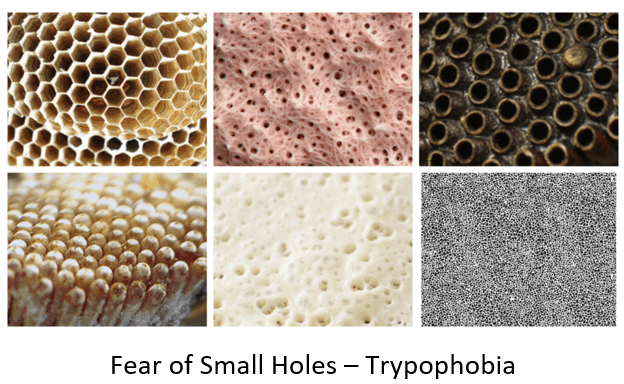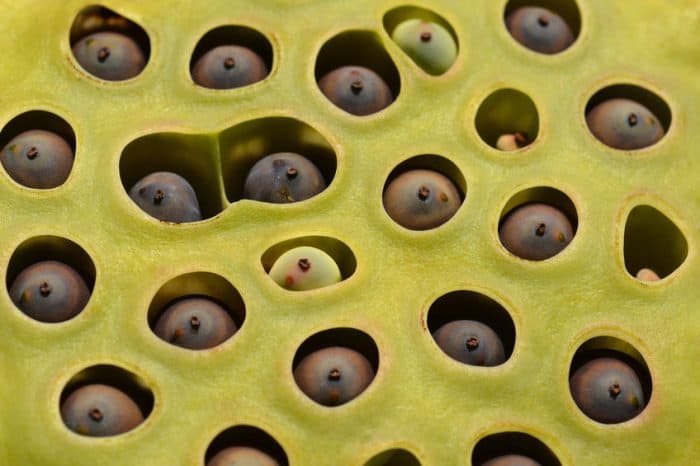Share This Article
Do You Suffer from Fear of Holes or Trypophobia?
When you see a sponge do you break out in a sweat?
Do things with holes such as a honeycomb or even spots on a leopard cause you to want to run or look away?
If so, then you are like many others who suffer from a fear of holes. There is hope—once you understand why you feel this way—to learn to cope with the fear of holes.
Trypophobia Meaning?
Many ask what the medical term is for a fear of holes, and that is trypophobia. Trypophobia is a fear of holes including fear of small holes, fear of multiple holes, and fear of holes in the skin to name a few.
The fear of holes phobia is a common occurrence with a variety of symptoms. A few individuals may only feel a bit queasy when they notice someone with measles or poison ivy while another person may have a panic attack.
In most cases, fear of holes or trypophobia is associated with dots or a fear of things with holes.
Trypophobia is from the Greek words trypta meaning “holes” and phobos which is “fear.” Even though the words are from ancient Greek, the first report of this fear was seen in 2005 on a website forum.
Individuals suffering from the fear of holes have an emotional or physical reaction when they see spots or holes, with the larger clusters creating a more intense reaction.

What Causes Trypophobia?
Even though research is ongoing, the cause of trypophobia is unknown.
Researchers believe that reactions to a fear of holes clustered together could be due to feelings of danger. The fear of holes may be a type of genetic behavior to protect oneself from danger. The reason being is that many poisonous animals have similar patterns, such as the pufferfish.
Another idea is that many diseases have clustered patterns, such as smallpox, which in the past killed thousands. This could be a genetic factor for fear of holes.
Others believe that since an image of items with holes can bring on the same reaction as seeing it in person, it could be a sensitivity to the mixture of dark and light in the images. The visual energy of these images can bring on reactions such as closing one’s eyes or turning away.
One other group of researchers have noted that the fear of holes may resemble eyes staring at a person which can bring on anxiety, thus the fear of holes begins. If these researchers are correct, the fear of holes may be attributed to social anxiety.
At the Centre for Brain Science, University of Essex, researchers Arnold Wilkins and Geoff Cole are studying trypophobia meaning. In their study, they used photos that can be found on Trypophobia.com. During their study, the discovery showed that individuals sensed danger when they viewed the photos. However, the type of danger is still unknown.
Whether it is a genetic or a developed phobia, the fear is very real to those that suffer from trypophobia.
Trypophobia Triggers
Common items found in our homes can cause trypophobia triggers. A few of the triggers include:
- Spotted animals
- Holes in concrete
- Bubbles in pancake batter as it cooks
- Air holes in cakes or bread
- Showerhead
- Sponges
- Head of a lotus flower
- Coral
- Honeycomb
- Strawberries
- Bubbles
- Beehives
- Pomegranates
- Skin problems like freckles or sores
Symptoms of Trypophobia
Physical Symptoms of Fear of Holes Include:
- Shortness of breath
- Nausea
- Fast heartbeat
- Sweating
- Trembling
- Itching
- Goosebumps
- Skin crawling
Psychological Symptoms of the Fear of Holes
The fear of holes also has psychological symptoms which include:
- Discomforting feelings
- Feelings of disgust
- Feelings of dread
- Feelings of danger
- Fear
- Panic attacks
Is There a Trypophobia Cure?
At this time, there is no cure for trypophobia, and there are no specific treatment options outlined for therapists. The reason being is that according to the American Psychiatric Association, trypophobia does not mean the standard to be a true phobia. For phobias to meet the standard the fear must interfere with your ability to do everyday tasks.
Some individuals have found treatments that have helped them cope with their fear of holes.

Treatments for Trypophobia
Self-help. What can I do to help myself with trypophobia?
The self-help treatments can be done alone, or you can seek professional help to ensure you are getting the most from your treatment.
Modifications to your lifestyle may help, such as exercising, getting adequate sleep, eating healthy, and avoiding stimulants like caffeine.
Try joining a self-help group. You can find group therapy with others suffering with trypophobia. Options may be available online or contact a counseling office to see if there may be some in your area. Talking with others that have a fear of holes can provide you with information on the way in which they cope with their fears.
Learning relaxation techniques may aid you when you cannot avoid seeing small holes.
Professional help options
Cognitive behavioral therapy, often referred to as CBT, provides you with a therapist that will help you talk through your fear of holes. This type of therapy will help you realize how your feelings and behaviors are associated. With the help of a therapist, you can set as well as achieve your goals. The therapy will help you understand that the fear of holes is irrational which will allow you to overcome the fear.
Exposure therapy may also be used along with cognitive behavioral therapy. The therapy will expose you to images that have holes. In order to overcome the fear of holes, slow and managed exposure may help as you will be in a safe and calm environment. Beginning with photos of holes or items with holes that may not cause a severe reaction until you can view other items that have been overwhelming in the past.
Medications used for trypophobia – fear of holes
When necessary, if your symptoms of trypophobia are causing you to have high anxiety or panic attacks, your physician may prescribe medication. The medications often given are antidepressants, beta blockers, or tranquilizers.
How to Avoid Trypophobia: Simple Tips
You may not be able to avoid every hole or pattern that brings on unwanted reactions, but you can work toward overcoming the fear of holes.
As with many phobias, triggers are the most important part to consider. Once you learn what triggers the fear, besides just the sight of a strawberry or small holes in your skin, you can adjust your life to avoid the feelings that bring on the panic.
Facts about Trypophobia
- When seeking help for trypophobia, you must remember that some doctors and therapists do not believe this is a real phobia. However, many individuals around the world have the same symptoms you are experiencing.
- Individuals who suffer from fear of holes normally get nauseous at the sight of clustered holes or sores.
- Symptoms of typophobia include seeing a trigger that will bring on an emotional and physical reaction including sweating or itching. The trigger is what brings on the symptoms while the rest of the time, you will be fine and feel no fear.
- In order to diagnose trypophobia, a therapist will have to watch your reactions when you view photos of things with small holes, large holes, and clusters of small dots.
You can lead a normal life with a fear of holes. With the help of a therapist, you may be able to turn those negative thoughts around and experience fewer symptoms.


